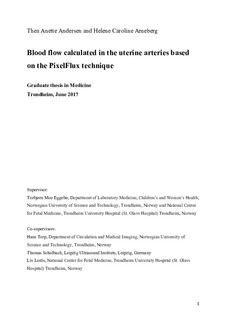| dc.description.abstract | Introduction: We aimed to compare two Doppler methods which calculate blood flow in the uterine arteries. We also aimed to explore associations between blood flow with birthweight and with fetal weight-gain/day from sonography to delivery.
Material and methods: We conducted a prospective observational pilot study in pregnancy week 24-25 in women with risk pregnancies referred to the fetal medical centre at St. Olavs Hospital, Trondheim, Norway from March 2016 to June 2016. Blood flow in the uterine arteries was calculated based on time-averaged peak velocity (TAmax) and on the PixelFlux technique. PixelFlux is a new method based on pixelwise calculation of spatially anglecorrected velocities and areas of all pixels inside a vessel during a heart cycle.
Results: The mean flow calculated from PixelFlux was 811ml/minute (median 777, range 209-1988 ml/minute) and mean flow using calculation from TAmax was 787 ml/minute (median 710, range 179 – 2120 ml/minute). The intra class correlation coefficient was 0.83 (95% CI 0.72-0.90) and limits of agreement were -441 ml/minute (95% CI -558 to -324 ml/minute) to 489 ml/minute (95% CI 372 to 606 ml/minute). We observed a significant association between mean flow calculated from PixelFlux and birthweight (r =0.41; p<0.01) and between flow calculated from PixelFlux and weight gain/day (r =0.33; p =0.02). Calculation based on TAmax was significant associated to birthweight (r =0.34; p =0.02), but not to weight-gain/day. Pulsatile index was not associated to flow, birthweight or fetal weight-gain/day.
Conclusions: The PixelFlux method might be a promising tool in predicting fetal growth. | nb_NO |
